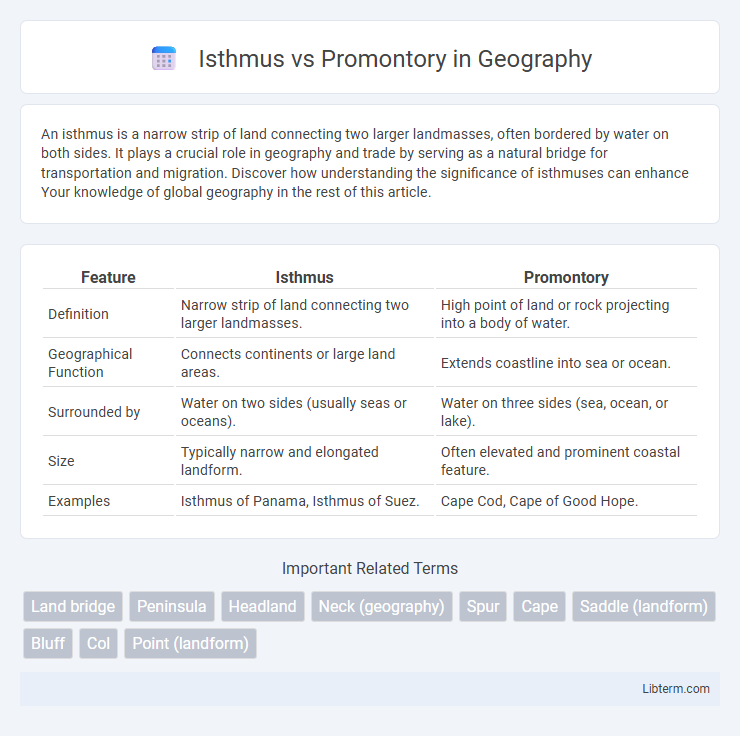An isthmus is a narrow strip of land connecting two larger landmasses, often bordered by water on both sides. It plays a crucial role in geography and trade by serving as a natural bridge for transportation and migration. Discover how understanding the significance of isthmuses can enhance Your knowledge of global geography in the rest of this article.
Table of Comparison
| Feature | Isthmus | Promontory |
|---|---|---|
| Definition | Narrow strip of land connecting two larger landmasses. | High point of land or rock projecting into a body of water. |
| Geographical Function | Connects continents or large land areas. | Extends coastline into sea or ocean. |
| Surrounded by | Water on two sides (usually seas or oceans). | Water on three sides (sea, ocean, or lake). |
| Size | Typically narrow and elongated landform. | Often elevated and prominent coastal feature. |
| Examples | Isthmus of Panama, Isthmus of Suez. | Cape Cod, Cape of Good Hope. |
Introduction to Isthmus and Promontory
An isthmus is a narrow strip of land connecting two larger landmasses and separating two bodies of water, playing a crucial role in land connectivity and marine navigation. A promontory is a high point of land or rock projecting into a sea or ocean, often serving as a prominent landmark for coastal navigation. Both geographical features significantly influence coastal ecosystems and have strategic importance in natural and human geography.
Defining Isthmus: Features and Formation
An isthmus is a narrow strip of land connecting two larger landmasses, characterized by its slender width and surrounded by water on both sides, facilitating land-based connectivity. It forms through tectonic activity, sediment deposition, or changes in sea levels, often emerging as a result of geological processes such as plate movements or erosion. Key examples like the Isthmus of Panama highlight its strategic importance for biodiversity corridors and human transportation infrastructure.
What Is a Promontory? Key Characteristics
A promontory is a high, prominent mass of land that juts out into a body of water, typically the sea, offering strategic vantage points and distinct geological features. Key characteristics include its elevated terrain, steep cliffs, and significant visibility that distinguish it from surrounding coastal areas. Unlike an isthmus, which connects two larger landmasses, a promontory projects outward, enhancing coastal navigation and defense.
Geological Processes Behind Isthmus and Promontory Creation
Isthmuses form through tectonic activity and sediment deposition where rising land bridges two larger landmasses, often influenced by sea level changes and erosion. Promontories develop from resistant rock outcrops shaped by differential erosion, tectonic uplift, or volcanic activity, projecting into water bodies. Both features reflect complex interactions of geological forces including plate movements, weathering, and sediment transport.
Famous Examples of Isthmuses Around the World
The Isthmus of Panama, connecting North and South America, is one of the most famous isthmuses, crucial for global trade due to the Panama Canal. The Isthmus of Suez between Africa and Asia hosts the Suez Canal, a pivotal maritime route linking the Mediterranean Sea and the Red Sea. Another notable example is the Isthmus of Tehuantepec in Mexico, a key land bridge between the Gulf of Mexico and the Pacific Ocean, important for regional transportation and biodiversity.
Notable Promontories: Iconic Headlands Globally
Notable promontories such as Cape Horn, the southernmost headland of South America, and the Rock of Gibraltar, a strategic point at the entrance of the Mediterranean, serve as iconic global landmarks defining coastlines. These natural high points function as navigational aids and are often rich in biodiversity, contrasting with isthmuses, which are narrow land strips linking larger land masses. Promontories like Point Reyes in California and Cape of Good Hope in South Africa are celebrated for their dramatic cliffs and historical maritime significance.
Comparing the Functions of Isthmus and Promontory
An isthmus functions as a narrow land bridge connecting two larger landmasses, facilitating transportation, trade, and migration between regions. In contrast, a promontory is a high point of land projecting into a body of water, often serving as a strategic lookout or navigational landmark. Both landforms play crucial roles in geography: isthmuses enable terrestrial connectivity while promontories influence maritime navigation and coastal ecosystems.
Ecological Significance of Isthmus vs Promontory
An isthmus serves as a critical ecological corridor connecting two larger landmasses, facilitating species migration and genetic exchange, which enhances biodiversity and ecosystem resilience. Promontories, typically elevated landforms extending into water bodies, create unique microhabitats that support specialized plant and animal communities, influencing coastal ecosystems and marine life breeding grounds. Both isthmuses and promontories play vital roles in shaping local ecology, but isthmuses primarily enable terrestrial connectivity while promontories impact aquatic-terrestrial interface environments.
Historical and Cultural Importance
An isthmus, such as the Isthmus of Panama, has historically been crucial for trade and cultural exchange, linking continents and enabling maritime routes like the Panama Canal that reshaped global commerce. Promontories, exemplified by the Rock of Gibraltar, served as strategic military and navigational landmarks, controlling access to key sea passages and fostering cultural intersections. Both landforms have influenced human history by shaping settlement patterns, defense strategies, and economic development in their regions.
Conclusion: Key Differences and Insights
An isthmus is a narrow strip of land connecting two larger landmasses, while a promontory is a high point of land extending into a body of water. Isthmuses primarily serve as natural land bridges influencing migration and transportation, whereas promontories affect coastal navigation and offer strategic vantage points. Understanding their geological formation and functional significance highlights their distinct roles in geography and environmental studies.
Isthmus Infographic

 libterm.com
libterm.com